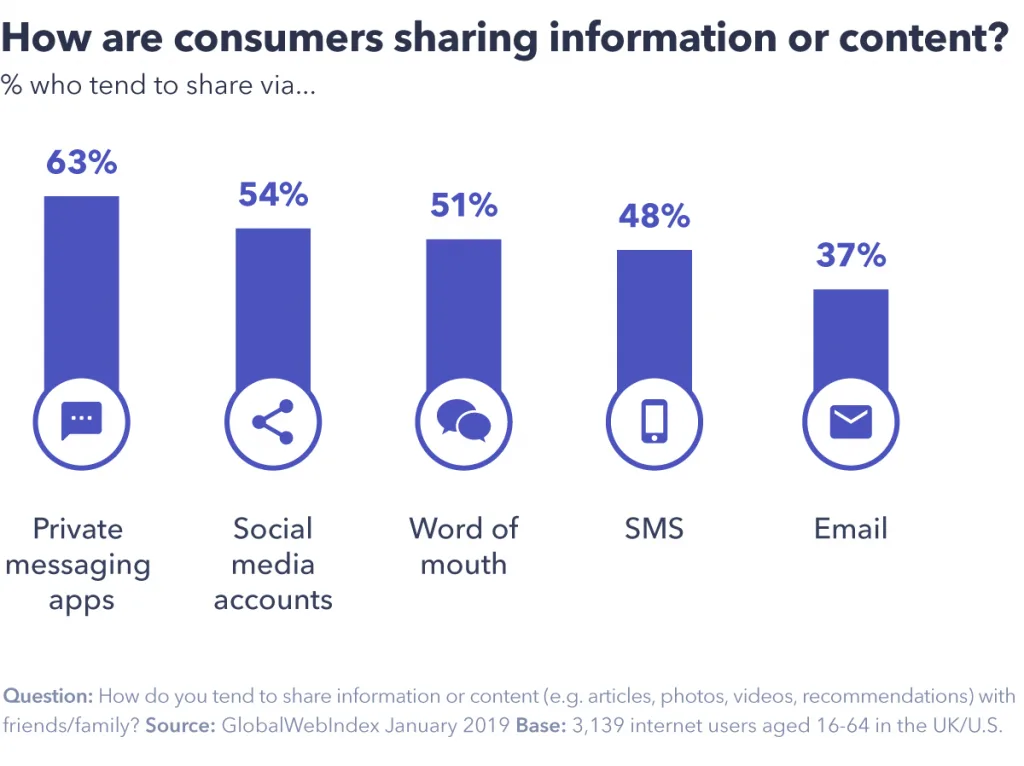Dark Social: The Hidden Traffic That Could Be Driving Your Brand

You might think you have a clear picture of how your content is shared, but there is a type of traffic most marketers cannot see. It is called dark social and it could be bigger than you realize.
Dark social includes content shared through private channels like messaging apps, email, SMS, or even word of mouth. Since these shares happen in closed spaces, regular analytics often miss them, leaving a blind spot in your data. Understanding dark social can give you a clearer view of your audience and the real impact of your content.
What Is Dark Social Media?
Dark social is any sharing that happens in private, non-public spaces. Dark social media include:
- Messaging apps such as WhatsApp, Facebook Messenger, Discord, Slack, Telegram, and WeChat
- Emails, both personal and professional
- SMS or text messages
- Private social groups, forums, and communities
- Word-of-mouth, phone calls, and video calls
- Content shared through workplace tools like Slack or Zoom
- Virtual and in-person events where content is passed along directly
These shares often appear as “direct” or “unknown” traffic in analytics because they do not carry referral data. The term dark social was first introduced by Alexis Madrigal in 2012 to explain traffic that looked direct but actually came from private sharing.
Why Dark Social Matters
Dark social is more than invisible traffic. It is where a large portion of your content actually spreads.
People are more likely to share content in private spaces than on public social media. According to Global Web Index, 63 percent of consumers prefer messaging apps like WhatsApp or Messenger when sharing online, compared to 54 percent who use open social platforms.

Source: GWI
This private sharing has important implications for marketers:
- Your reach may be larger than it appears. Traditional analytics often miss dark social activity, so campaigns can seem smaller than they actually are.
- Private shares feel personal and trusted. Recommendations shared directly are often more engaging and can reflect higher purchase intent.
- Understanding referral paths improves planning. Seeing how content moves in private channels can help you target campaigns more effectively.
Dark social may be hidden, but it is a powerful part of your content’s journey. Recognizing it lets you track performance more accurately, reach audiences that might otherwise be missed, and create content that feels personal and trusted.
Challenges of Dark Social
Dark social can be tricky to track, and understanding its impact comes with several obstacles:
- Invisible Sources: Sharing happens in private spaces like messaging apps, email, SMS, and private groups. Because referral data is missing, it is hard to know where traffic is coming from.
- Analytics Gaps: Traditional tools such as Google Analytics often label dark social traffic as “direct” or “unknown.” This can make traffic reporting less accurate and obscure patterns in user behavior.
- Tracking ROI: Without clear source data, connecting campaigns to conversions or revenue becomes difficult. This can make it harder to measure the true impact of your marketing efforts.
- Missed Insights: Private conversations and peer recommendations are hidden from public view, which means valuable feedback on customer motivations, attitudes, and perceptions is often lost.
These challenges make dark social a blind spot for many marketers, but they also highlight the potential value it holds.
Opportunities in Dark Social
Even though tracking is challenging, dark social opens doors for brands that are ready to engage more personally with their audience:
- Builds Trust and Authenticity: Shares between friends, colleagues, or family feel personal. This kind of private sharing often drives higher engagement and can influence decisions more than public posts.
- Expands Audience Reach: Private channels let your content travel beyond visible social platforms, reaching audiences who might otherwise never see it.
- Strengthens Relationships: Sharing in personal contexts encourages deeper connections and brand loyalty. Craft content designed to be shared privately to take advantage of this.
- Provides Actionable Insights: Combining methods such as UTM parameters, personalized referral links, and social listening in private communities can reveal trends and buyer intent.
- Improved Tracking Options: Use URL shorteners with tracking codes, specialized dark social analytics tools, surveys, and direct traffic analysis to identify hidden sharing patterns and understand your audience better.
How to Measure Dark Social Traffic
Dark social may feel invisible, but there are ways to get a clearer picture of its impact. Because shares happen in private channels like messaging apps, email, and SMS, most analytics tools mark this traffic as direct or unknown. The good news is you can still track and analyze it using a combination of strategies and tools.
1. Google Analytics
Google Analytics can help uncover dark social traffic if you use a few simple techniques. These methods allow you to see how content is shared privately and understand its real impact.
- Add UTM Parameters: Include UTM tracking codes in your campaign URLs and shared content. This way, even if someone copies a link and shares it through email, WhatsApp, or Messenger, you can still identify the original source.
- Monitor Direct Traffic Patterns: Keep an eye on spikes in direct traffic, especially after campaigns, events, or offline promotions. Sudden increases that do not match your paid or organic activity often signal dark social sharing.
- Analyze Landing Pages: Focus on pages receiving high direct traffic. Look at metrics such as session duration, bounce rate, and user engagement. This helps you understand which content resonates most in private shares.
- Use Event Tracking and Custom Dimensions: Set up events and custom dimensions in Google Analytics to track interactions from dark social links. This goes beyond simple page views and provides a clearer picture of user behavior and engagement.
- Filter Out Known Direct Traffic: Not all direct traffic is dark social. Separate visitors who type your URL directly or bookmark your homepage. Removing these known sources helps isolate traffic that is likely coming from private sharing.
2. Use URL Shorteners and Custom Links
Shortened URLs tidy up posts and simplify tracking. Tools like Ow.ly allow you to add custom tracking parameters to links, making it easier to monitor specific campaigns. UTMs work too, giving you clear insights into source, medium, content, and campaign for every share.
3. Social Listening
Social listening tools like Brandwatch can’t capture everything, such as text messages, but they provide valuable insight into semi-private sharing. You can monitor brand mentions, conversations about products, and trends across the web, uncovering feedback that would otherwise be invisible. For example, real user reviews or recommendations often drive more conversions than public posts alone.
4. Email Tracking
Email is a major dark social channel, but you can track how your content spreads by adding UTM codes or shortened links. Analyze click-throughs, forwards, and visits to see which emails get shared privately. Some platforms also provide forwarding metrics for extra insight. This uncovers private sharing flows that would otherwise go unnoticed.
5. Referral Patterns and Direct Traffic Analysis
Keep a close eye on your referral and direct traffic. Sudden spikes that don’t match your paid campaigns or organic posts can signal dark social activity. Pair this analysis with landing page performance and engagement metrics to see which content is driving private shares. Over time, these patterns help you spot trends and adjust your content strategy for better reach.
6. Surveys and Self-Attribution
Add optional questions in forms or chatbots, like “How did you hear about us?” This gives users a chance to report dark social referrals directly. Gathering this information provides context about your audience and the channels they use. It also helps you refine future campaigns based on real user behavior.
7. Include Buttons to Share to Private Channels
Add sharing buttons for private channels like WhatsApp, Messenger, and email across your website or blog. Pair these buttons with UTM codes to track exactly which content is being shared. Making sharing simple encourages more private referrals and turns hidden activity into measurable data. Over time, this creates a clearer picture of your content’s true reach.
8. Advanced Analytics and AI
Use predictive analytics and AI tools to identify behavioral patterns that hint at dark social traffic. These insights reveal trends that traditional metrics often miss. By analyzing this data, you can better understand audience behavior and measure the real reach of your campaigns. This approach also uncovers hidden opportunities to engage with your most active audiences.
Making the Most of Dark Social
While it may seem invisible, dark social can be a powerful source of engagement. Brands that focus on personalized content, tracking strategies, and qualitative research can turn private sharing into measurable opportunities. By understanding and embracing these hidden networks, marketers can grow their audience, strengthen relationships, and gain deeper insights into customer behavior.

